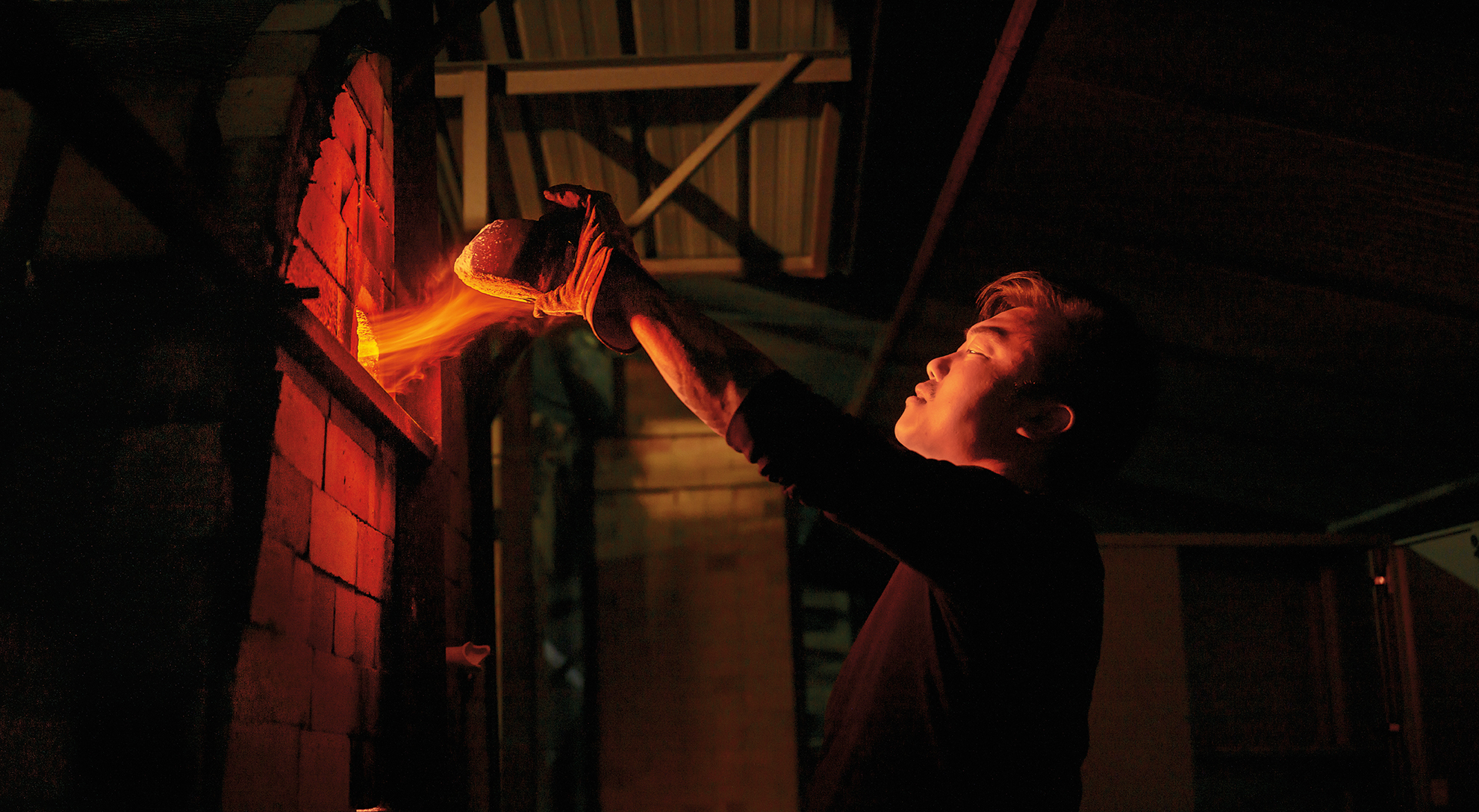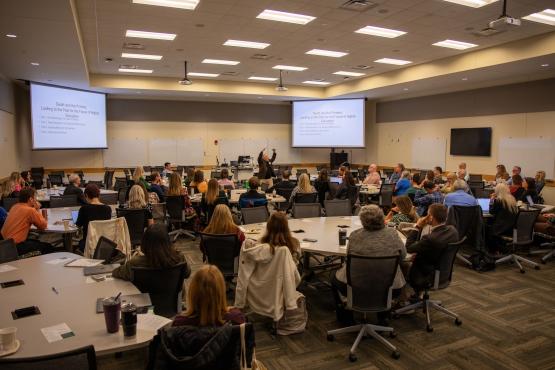Ohio University is home to the nation’s No. 3-ranked Master of Fine Arts in ceramics and the top U.S. program outside of an arts academy. No other academic program at OHIO is more highly ranked by U.S. News and World Report, the gold standard in higher education rankings. OHIO’s reputation has been built, quite literally, brick by brick, fueled by an ever-growing and evolving cadre of atmospheric kilns designed and constructed over the years by students and visiting artists who have gone on to lead ceramics departments and fill gallery shelves around the world.
There’s something about fire: Its warmth, its constant movement and shifting colors, its ability to destroy but also to create and to nourish. Anyone who has spent an evening around a campfire can attest to its uncanny power to mesmerize.
So naturally, on a fall Thursday night in Athens, long after dark, the orange flames pouring out of a chimney on North Green draw curiosity. Behind a chain-link fence, you can hear laughter and a bit of chaos. A handful of students scramble to throw up a small tent as rain starts to fall.
That rain won’t deter the flames as the students continue to stoke the fire box of a catenary arch kiln filled to the brim with hand-thrown pottery and ceramic sculpture created just around the corner in undergraduate ceramics courses.
The students are damp and tired but giddy with anticipation. Behind a brick kiln door that they helped build is artwork—their artwork—in progress. As the fire burns, ash moves through the kiln and settles on the surface of their work. Their current mission is to keep the heat rising, slowly, until the kiln reaches around 2,300 degrees Fahrenheit and that ash melts into glass, forming natural glaze reminiscent of the fire itself. Colors range from copper to purple to soft gray. Some surfaces appear polished by the movement of air and flames inside the kiln. Others are matte and dense with collected fly ash.
“You’re basically putting a canvas—your pot—into the kiln,” says Brad Schwieger, Ohio University professor emeritus of ceramics. “What happens to it inside the kiln becomes part of the finished work of art.”
What Schwieger describes is at the heart of what is known in the ceramics world as atmospheric firing: firing with wood to create ash glaze or with salt or sodium oxide (soda), both of which vaporize and interact with the surface of the pot to create a unique and natural glaze. Unlike an applied glaze on a piece fired in an electric kiln, atmospheric firing introduces an element of the unknown. The movement of air, fire, heat and vapor inside the kiln can be partly manipulated—but never entirely controlled.
At many universities, a ceramics student might have the opportunity to fire with wood or soda once or twice, as part of a special event. At OHIO, students studying ceramics at all levels not only have the opportunity to fire in multiple different types of atmospheric kilns, but also to design and build their own, with the best being added to the structures that comprise OHIO’s kiln yard.
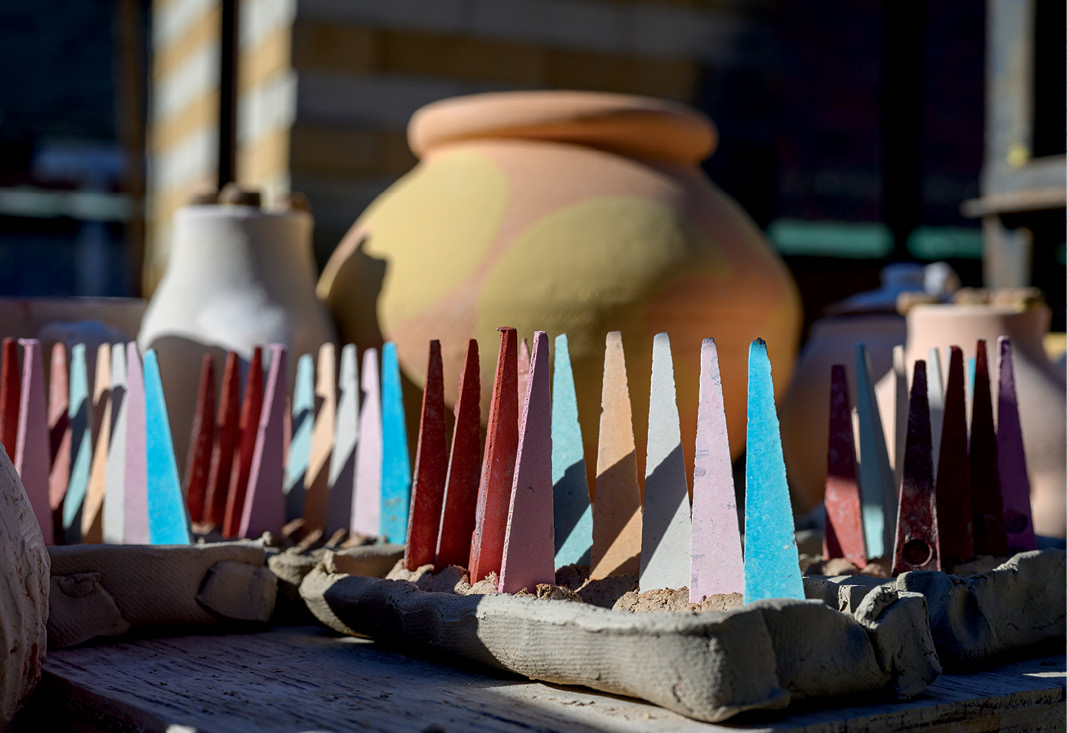
Pyrometric cones, which melt at different temperatures, will be loaded into a kiln to help those monitoring the firing gauge how hot it is. Photo by Ben Wirtz Siegel, BSVC ’02
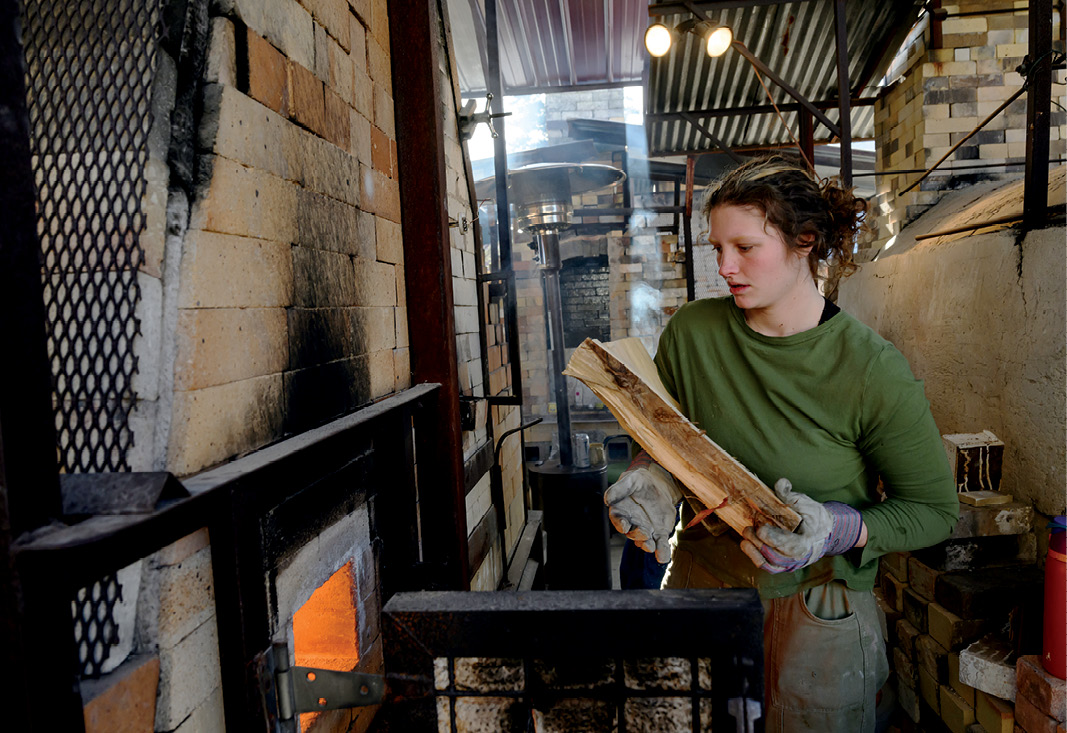
Fourth-year BFA student and Club Clay President Kylie Houghton stokes the catenary arch kiln during a 48-hour wood firing. Photo by Ben Wirtz Siegel, BSVC ’02
If these kilns could talk
When Schwieger arrived at OHIO in 1990, the kiln pad was a small, 1,000-square-foot slab of concrete with a couple of kilns in desperate need of repair. He got to work building and rebuilding, with plenty of help from Robert “Boomer” Moore, who worked as a studio coordinator and kiln technician at OHIO before taking a job at West Virginia University, where he now leads the ceramics program.
When the duo ran out of space, they scraped together funds to triple the size of the concrete kiln pad and kept building. Over the years, students and visiting artists contributed, each becoming a part of OHIO’s incredible atmospheric firing story:
- Ted Adler, MFA ’02, designed and built a Bourry box kiln that still stands today. He now is a gallery artist and teaches ceramics at Wichita State University.
- Mike Jabbur, MFA ’08, built a small reduction gas glaze test kiln. Today he is a ceramics professor at William & Mary.
- James Tingey, MFA ’12, built a tube kiln before taking a job at Alfred University, home to the No. 2 ceramics program in the country.
- During a student exchange, German ceramic artist Jochen Dobers of Burg Giebichenstein University of Art and Design built a unique updraft salt kiln, which has a companion kiln at Dobers’ university in Halle, Germany.
“If a student or an artist comes here and has an idea for a kiln that would really support their work, we’ll build the thing,” Schwieger says. “Not everybody will do that.”
Alumni outside of the ceramics program have left their mark as well. The newly renovated building next to the kiln yard reopened this fall as the Levy Ceramics Studio, named for a gift that honors the family of Dave Levy, BS ’78, and Cathy Levy.
“Everything came together in this amazing way,” says Dave, who is also a former member of The Ohio University Foundation Board. While neither he nor Cathy are ceramicists themselves, Dave’s mother “was absolutely passionate as a potter, and it was contagious,” he recalls.
That, plus Cathy’s position on the Chaddock + Morrow College of Fine Arts Leadership Council, meant the gift “checked a lot of boxes,” Cathy adds. “It helped a fabulous program that is nationally recognized, and it’s wonderful to be associated with that. … Hopefully we’re setting an example of what people like us can do and motivating others to follow that example.”
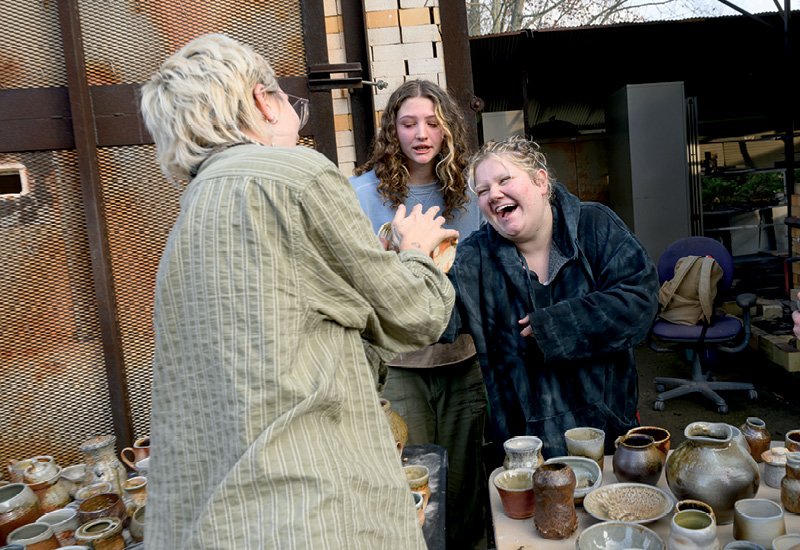
Undergraduate ceramics majors unload pots after a successful atmospheric firing. Photo by Ben Wirtz Siegel, BSVC ’02
Passing the torch
Schwieger’s passion for atmospheric firing and “let’s build the thing” mindset defined OHIO’s ceramics program over a 30-year span. In 2009, he found a partner in Tom Bartel, who joined the ceramics faculty and brought a more sculptural approach to his work. But when Schwieger decided to retire in 2022, Bartel knew they needed to hire someone who would keep the atmospheric firing going.
Around the same time, fate brought Stuart Gair, BA ’12, back to Athens. Gair had studied history as an undergrad, but met his future wife in one of Schwieger’s ceramics classes. He fell in love with her and with clay, ending up at the University of Nebraska for an MFA in ceramics. He went on to be an artist-in-residence at Harvard University and the Archie Bray Foundation, but decided to return “home” and purchase property that had once served as the Big Chimney Baking Co. This summer, Gair and his wife, Kristie (Schleich) Gair, BFA ’13, reopened the property as Canaanville Arts Center studio and gallery.
Gair’s artistic scholarship and passion had been specifically in soda firing, and he has extensive experience with various types of atmospheric kilns.
“Every pot is individualized,” says Gair, also an assistant professor of instruction in the ceramics program, about why he is drawn to this type of firing. “Having a pot coming out of the kiln that has a flame path on it and was placed in the kiln in a particular way to enhance the form … that’s going to create a strong connection between the maker and the vessel.
“But the main thing this kind of firing does is, it creates community. It brings people together in a way that nothing else can in terms of ceramics, or really any type of art. During the firing itself, even if you’re not on shift, people tend to hang around the kiln. ... You’re making connections with people in a different way than you would in just a classroom session.”
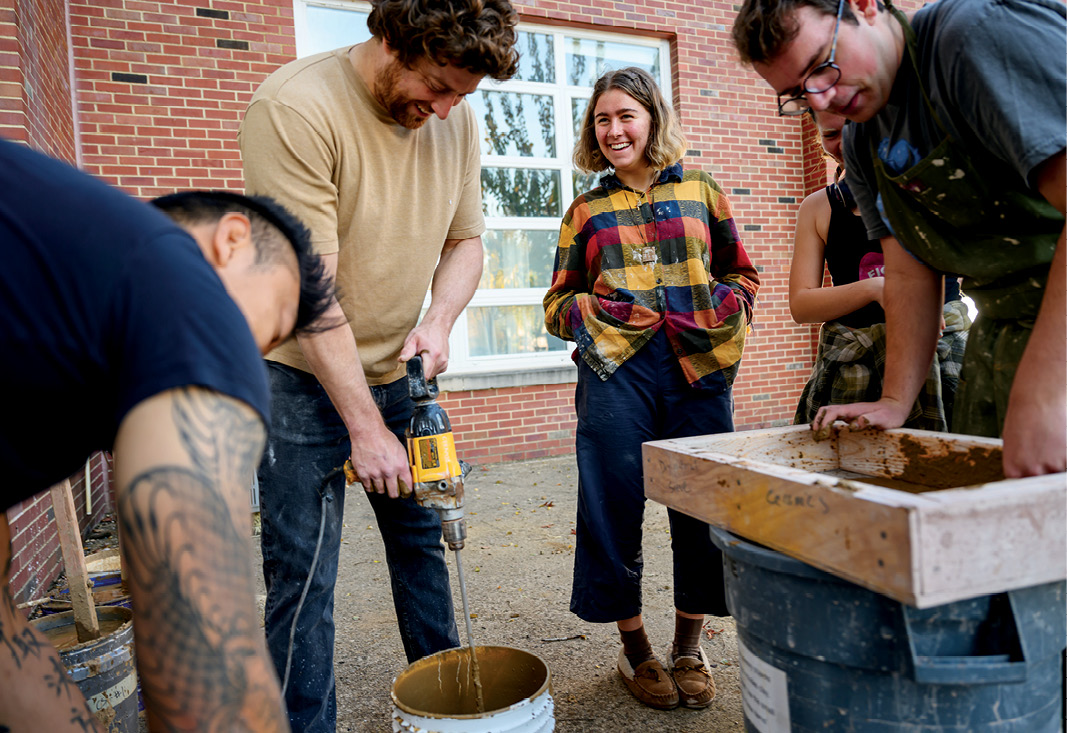
In addition to operating Canaanville Arts Center with his wife, Stuart Gair (center, holding a drill) teaches ceramics classes at OHIO. Here, he and students in his Ceramics Wheel Throwing I class work on a “clay dig” to process wild clay found locally in Athens County. Photo by Ben Wirtz Siegel, BSVC ’02
Gair envisions an exciting next chapter for OHIO ceramics that is even more connected to the region and is centered around artists working in community. A new student group, Club Clay, has already begun experimenting with an upcycled wood kiln at his home studio. With leadership from MFA students Jason Wang and Sam McCall, OHIO’s first Atmospheric Firing Conference took place in early June, featuring nine kiln firings by 10 artists.
As for Schwieger, he’s still making and selling pottery at his home studio and enjoying watching the next generation of leadership.
“I love seeing it all continue to grow, and I’m excited to see what they do next,” Schwieger says, adding that he’s confident the opportunity to experiment with building and firing kilns will continue to attract young artists who will leave their own mark on the program and the future of ceramics for decades to come.
Robin Oliver is the vice president of University Communications and Marketing.
Feature photo: Jason Wang, MFA ’25, checks a kiln in OHIO’s kiln yard. Wang was one of two ceramics graduate students who organized last summer’s inaugural Ohio University Atmospheric Conference. Photo by Ben Wirtz Siegel, BSVC ’02


